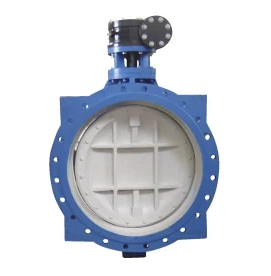HP butterfly valves are a type of high-performance butterfly valve designed to meet the demands of critical industrial applications that require reliable and efficient flow control. HP butterfly valves are commonly used in the chemical, oil and gas, and power generation industries, among others.
Some key features of HP butterfly valves include:
High temperature and pressure resistance: HP butterfly valves are designed to withstand high temperatures and pressures, making them suitable for use in demanding applications.
Tight shut-off: HP butterfly valves are designed to create a tight seal when closed, which helps to prevent leakage and reduce the risk of contamination.
High flow capacity: HP butterfly valves have a high flow capacity, which makes them suitable for use in applications that require high flow rates.
Low torque operation: HP butterfly valves are designed to operate with low torque, which can help to reduce wear and extend the lifespan of the valve.
Corrosion resistance: HP butterfly valves are made from materials that are resistant to corrosion, which makes them suitable for use in harsh environments.
Easy maintenance: HP butterfly valves are designed for easy maintenance, with components that can be easily accessed and replaced as needed.
When selecting an HP butterfly valve, it is important to consider factors such as the size and pressure rating of the valve, the type of fluid being transported, and the operating conditions of the system. Proper installation and maintenance procedures are also important to ensure the reliable and efficient operation of the valve over its lifespan.
Some recommended installation andmaintenance procedures for HP butterfly valves include:
Installation:
Ensure that the valve is properly sized and rated for the application, including the flow rate, pressure, and temperature of the fluid being transported.
Verify that the valve is compatible with the piping system and any other components such as actuators or controllers.
Install the valve in the correct orientation, with the flow direction indicated by the arrow on the valve body.
Tighten the valve flange bolts to the manufacturer’s recommended torque specifications.
Verify that the valve is operating properly before putting it into service.
Maintenance:
Inspect the valve regularly for signs of wear or damage, such as cracks, corrosion, or leakage.
Lubricate the valve as needed to ensure proper operation and prevent wear.
Check the sealing surfaces of the valve disc and seat for any signs of damage or wear that may affect the tightness of the seal.
Inspect the valve stem for any signs of damage or wear, and replace any worn or damaged parts as needed.
Check the valve actuator or controller for proper operation and calibration.
Clean the valve and any associated piping regularly to prevent the buildup of debris or contaminants that may affect the performance of the valve.
Follow any additional maintenance procedures recommended by the manufacturer or a qualified engineer or valve specialist.
Overall, it is important to follow proper installation and maintenance procedures to ensure the reliable and efficient operation of HP butterfly valves over theirlifespan. Regular inspection, lubrication, and cleaning can help to prevent wear and damage, and identifying and addressing any issues promptly can help to reduce downtime and increase productivity. hp butterfly valve It is recommended to consult with a qualified engineer or valve specialist for specific guidance on the installation and maintenance of HP butterfly valves in your application.
Determining the correct size and pressure rating for an HP butterfly valve is important to ensure that it operates effectively and safely in your specific application.
Here are some steps you can take to determine the correct size and pressure rating for an HP butterfly valve:
Determine the flow rate: The flow rate of the fluid being transported is a key factor in determining the size of the valve. This can be calculated based on the size of the pipeline, the viscosity of the fluid, and the desired flow rate.
Calculate the required valve diameter: Once you have determined the flow rate, you can calculate the required valve diameter using the equation Q = Cv x √P x (SG) x D², where Q is the flow rate, Cv is the valve flow coefficient, P is the pressure, SG is the specific gravity of the fluid, and D is the diameter of the valve.
Select the appropriate pressure rating: The pressure rating of the valve should be equal to or greater than the maximum pressure of the fluid being transported. This will depend on the specific application and the properties of the fluid, such as its temperature and viscosity.
Consider any additional factors: There may be other factors to consider when selecting an HP butterfly valve, such as the type of fluid being transported, the temperature and pressure of the system, and any regulatory requirements or industry standards.
Consult with a qualified engineer or valve specialist: If you are unsure about the correct size and pressure rating for an HPbutterfly valve, it is always best to consult with a qualified engineer or valve specialist. They can help you to determine the most appropriate valve for your specific needs based on factors such as the flow rate, pressure, and temperature of the fluid being transported, as well as the operating conditions of the system.
In addition to these steps, it is important to ensure that the valve is compatible with the piping system and any other components such as actuators or controllers. Proper installation and maintenance procedures are also important to ensure the reliable and efficient operation of the valve over its lifespan.
By following these steps and consulting with qualified professionals, you can determine the correct size and pressure rating for an HP butterfly valve that will meet the demands of your specific application and ensure safe and effective operation.
